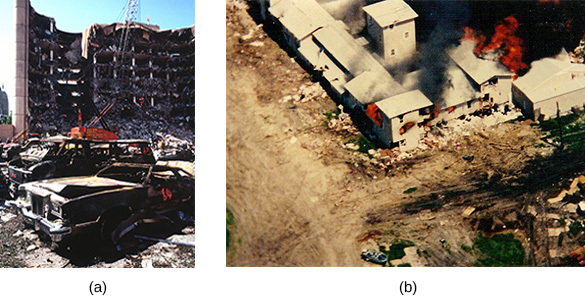| << Chapter < Page | Chapter >> Page > |
The fears of those who saw government as little more than a necessary evil appeared to be confirmed in the spring of 1993, when federal and state law enforcement authorities laid siege to the compound of a religious sect called the Branch Davidians near Waco, Texas. The group, which believed the end of world was approaching, was suspected of weapons violations and resisted search-and-arrest warrants with deadly force. A standoff developed that lasted nearly two months and was captured on television each day. A final assault on the compound was made on April 19, and seventy-six men, women, and children died in a fire probably set by members of the sect. Many others committed suicide or were killed by fellow sect members.
During the siege, many antigovernment and militia types came to satisfy their curiosity or show support for those inside. One was Timothy McVeigh, a former U.S. Army infantry soldier. McVeigh had served in Operation Desert Storm in Iraq, earning a bronze star, but he became disillusioned with the military and the government when he was deemed psychologically unfit for the Army Special Forces. He was convinced that the Branch Davidians were victims of government terrorism, and he and his coconspirator, Terry Nichols, determined to avenge them.
Two years later, on the anniversary of the day that the Waco compound burned to the ground, McVeigh parked a rented truck full of explosives in front of the Alfred P. Murrah Federal Building in Oklahoma City and blew it up ( [link] ). More than 600 people were injured in the attack and 168 died, including nineteen children at the daycare center inside. McVeigh hoped that his actions would spark a revolution against government control. He and Nichols were both arrested and tried, and McVeigh was executed on June 11, 2001, for the worst act of terrorism committed on American soil. Just a few months later, the terrorist attacks of September 11, 2001 broke that dark record.

For decades, the contours of the Cold War had largely determined U.S. action abroad. Strategists saw each coup, revolution, and civil war as part of the larger struggle between the United States and the Soviet Union. But with the Soviet Union vanquished, the United States was suddenly free of this paradigm, and President Clinton could see international crises in the Middle East, the Balkans, and Africa on their own terms and deal with them accordingly. He envisioned a post-Cold War role in which the United States used its overwhelming military superiority and influence as global policing tools to preserve the peace. This foreign policy strategy had both success and failure.
One notable success was a level of peace in the Middle East. In September 1993, at the White House, Yitzhak Rabin, prime minister of Israel, and Yasser Arafat, chairman of the Palestine Liberation Organization, signed the Oslo Accords, granting some self-rule to Palestinians living in the Israeli-occupied territories of the Gaza Strip and the West Bank ( [link] ). A year later, the Clinton administration helped facilitate the second settlement and normalization of relations between Israel and Jordan.

Notification Switch
Would you like to follow the 'U.s. history' conversation and receive update notifications?